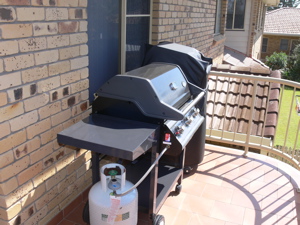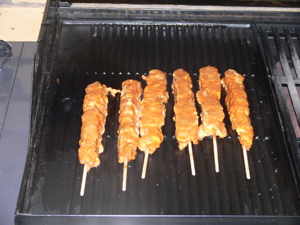Tuesday September 25, 2007 5:30 am Lennox Head, NSW Australia
I do not have Internet access at the moment.
A. Morning Musings
5:30 am

We continue to make progress. I now have the barbeque and a special patio table (aka computer desk) in the unit. I still have to put the barbeque back together and I plan to do that today. With a little luck we should have something cooking on it for dinner. We also have two wonderful afghan comforters to wrap around ourselves while watching television.
Television is now fine. They replaced the main unit with a new set at noon yesterday.
That leaves the internet connectivity problem. I was successfully able to copy a version of Internet Connect from another Mac and re-install it on my laptop. So that is now working. The actual connection to the internet is clearly working, but there is some problem with the initial handshake with the Telstra site and I am not able to make the connection that activates my account. I will try a phone call later this morning and see if that helps.
The sun is up - a perfect orange disc just above the horizon. And the first taste and aroma of the morning coffee is excellent.
| Immediate |
Description |
Time |
| Mathematics |
"Why Beauty is Truth: A History of Symmetry" by Ian Stewart |
1 hr |
| Literature |
"Three Dollars" by Elliot Perlman |
1 hr |
C. Actual Learning Activities
5:40 am
Mathematics 64
September 25, 2007
5:40 am
I read the third chapter of "Why Beauty is Truth" by Ian Stewart yesterday evening. There wasn't much math in the chapter but there was some nice poetry.
3. The Persian Poet
- Omar Khayyam is primarily remembered for the poem 'The Rubaiyat' [p. 33]
- Here is the opening quatrain of the chapter:
- Wake! For the Sun, who scattered into flight
The Stars before him from the Field of Night
Drives Night along with them from Heav'n and strikes
The Sultan's Turret
with a Shaft of Light
This captures the sunrise I am watching at the moment much more effectively than my "Oh, wow!"
- He also should be remembered for his solutions to the cubic equations. [p.33]
- "Around the year 100, Nichomachus, probably an Arabian hailing from Judea, wrote a book called Introductio Arithmetica in which he abandoned the Greek tradition of representing numbers by geometrical quantities such as lengths or areas. To Nichomachus, numbers were quantities in their own right." [p. 35]
- "Symbolism entered into algebra in the work of a Greek mathematician named Diophantus, sometime around 500. ... He wrote ...the 13 books of the Arithmetica. Six of them are still in existence. ... Mostly, the Arithmetica is about solving equations. The first surviving book discusses linear equations; the other five treat various kinds of quadratic equations, often in several unknowns, and a few special cubic equations. A key feature is that the answers are always integers or rational numbers. Today we call an equation 'Diophantine' if its solutions are restricted to integers or rational numbers." [p. 35 - 36]
- "Diophantine equations are central to modern number theory." [p. 36]
- "Algebra really arrived on the mathematical scene in 830, when the main action moved from the Greek world to the Arabic one. In that year the astronomer Mohamed ibn Musa al-Khwarizmi wrote a book called al-Jabr w'al Muqabala. The book explains how to solve linear and quadratic equations. [p. 36 - 37]
- "Al-Khwarizmi's immediate successors worked out how to solve a few special cubic equations. ... the most famous of them all is Omar Khayyam." [p. 37]
- "Making liberal use of conic sections, Omar developed geometric solutions for all cubic equations. ... He distinguished fourteen different types of cubic, depending on which terms appear on each side of the equation." [p. 41]
- Reading this book while in Australia makes another of Omar Khayyam's quatrains all the more striking:
- And lately, by the Tavern Door agape,
Came shining through the Dusk an Angel Shape
Bearing a Vessel on his Shoulder; and
He bid me taste of it; and 'twas - the Grape.
The barbeque is now operational. Lunch.






